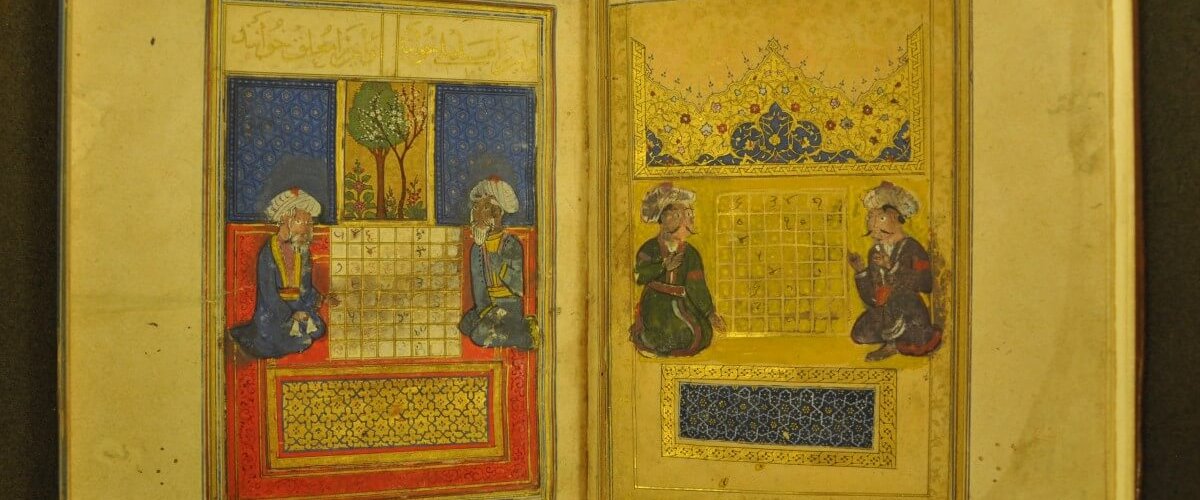Risāla i-Shaṭranj or Chess Treatise – by Dr Amy Matthewson
Risāla i-Shaṭranj or Chess Treatise
One of the more fascinating objects that is on display at the Royal Asiatic Society’s Extraordinary Endeavours: Celebrating 200 years of Communication, Collaboration and Dissemination exhibition is an early 15th century manuscript by the name of Risāla i-Shaṭranj (Chess Treatise). This beautiful manuscript, catalogued as Persian 211, includes information on the benefits of chess as well as 64 diagrams of chess problems. It also attributes the origins of the game to India, a statement that has historically caused much debate.

In 1763, a young 17-year-old William Jones wrote the poem Caïssa or The Game of Chess, that was inspired by a 1527 Italian poem titled “Scacchia, Ludus”. Jones created a mythical origin of chess, in which Mars, the god of war, seeks the assistance of a god of sport, who creates the game as a gift for Mars to win the favour of the nymph Caïssa. Mars is successful in his romantic endeavours and Caïssa is known in chess-circles as the ‘goddess’ of chess.
Jones later founded the Asiatic Society of Bengal and was a distinguished scholar, fluent in an impressive range of languages. His translation of a Sanskrit passage related to the game of chess was published in his essay, “On the Indian Game of Chess” (Asiatic Researches, 1790). He concluded, “If evidence be required to prove that chess was invented by the Hindus, we may be satisfied with the testimony of the Persians; who, though as much inclined as other nations to appropriate the ingenious inventions of other people, unanimously agree that the game was imported from the West of India” (Vol.2: 159).
Jones’ assertion appears to have annoyed Nathaniel Bland, member of the Royal Asiatic Society of Great Britain and Ireland, who wrote his own essay. Its title leaves no doubt to whom he was addressing; Bland’s “On the Persian Game of Chess” argues that the game originated in Persia, not India, accusing Jones of resting his conclusion “on the universal credence given to it by the Persians themselves” (Journal of the Asiatic Society, 1852: 63).

Then there is the argument that the game originated in China. The game is called “Elephant chess” because the elephant is one of the pieces of the game, moving like our Bishop, diagonally across the board. It has a different format but the basics of the game retain the foundation we are familiar with. H.F.W. Holt quotes Dr. Medhurst, stating that some Chinese people encountered the bones of elephants in ancient times and tried to imagine what the animal looked like when alive. Hence the character 象(xiàng) has come to mean both ‘elephant’ and ‘imagination, resemblance, etc’ (Journal of the Asiatic Society, 1885: 357).
Holt addresses the hypothesis that chess originated in India before extending to the Persians and Arabians; however, he notes that there is an “absence of any more precise indications from the early literature of India” and he therefore turns to China’s ancient records. He cites a dialogue recorded between Confucius and his disciples where, Holt states, we find Confucius saying “To do nothing but gorge one’ self all day without having any occupation for the mind, is indeed a difficult task. For is there not at least chess-playing? For a striving to attain is surely a worthy object?” (Journal of the Asiatic Society, 1885: 354).
A study of chess reveals that there are many forms, manifestations, and individual histories of the game as it travelled to Europe, Myanmar, Korea, Japan, Tibet, etc. It is now generally agreed that the game originated in India (with much continued debate), but what is undisputable is that the game is enjoyed globally. If you happen to visit the exhibition at the Brunei Gallery between the 12th October and 15th December, pay a visit to the Risāla i-Shaṭranj (Chess Treatise). Its wonderful illuminated panels and margins partly in gold is a must-see for chess lovers.

Thanks to Dr Matthewson! You can find out more about her work at her website amymatthewson.com

